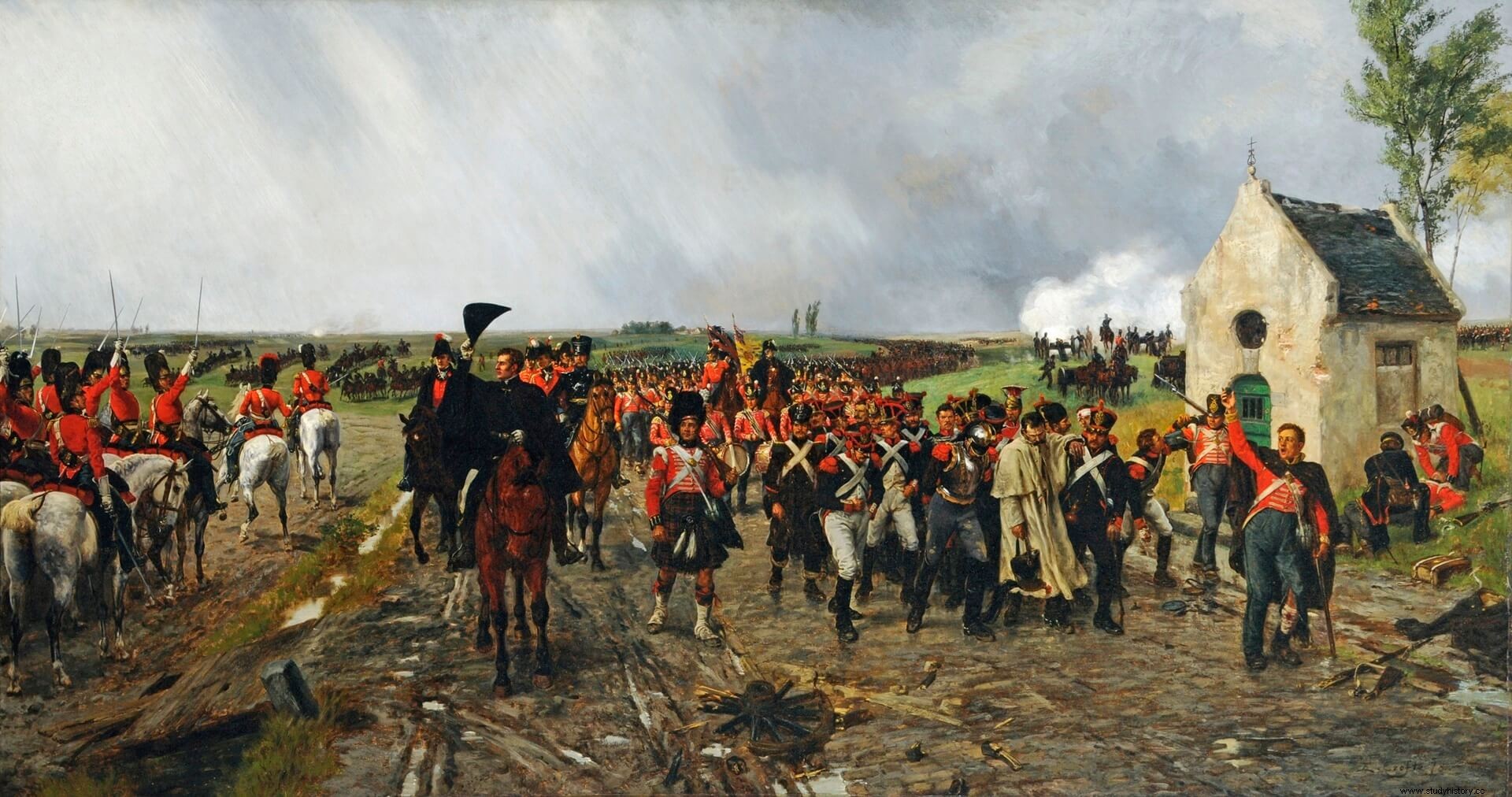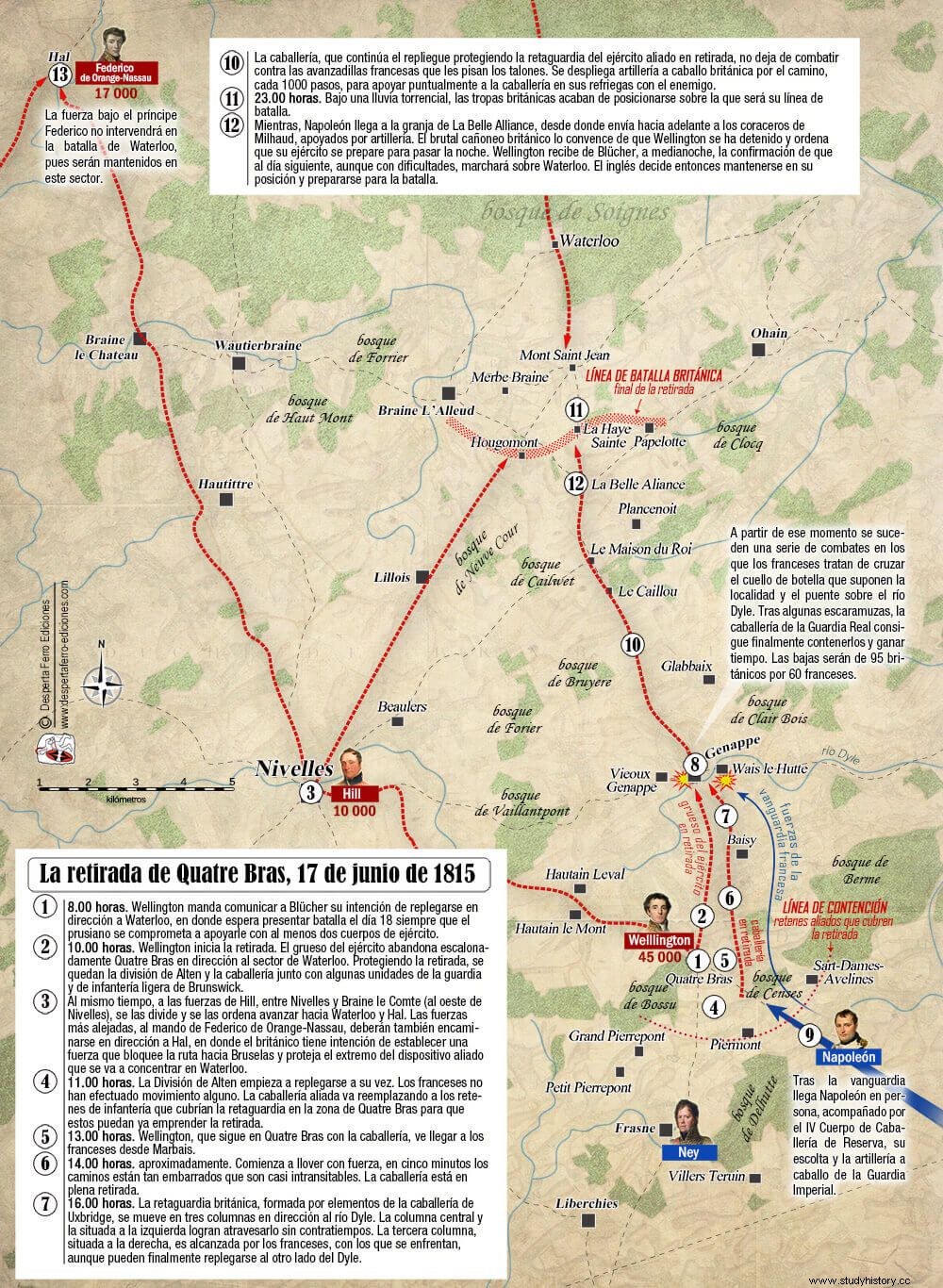
In fact, what he was concerned about was gathering the rest of his forces at the Quatre Bras junction to attack Marshal Ney's French forces who had opposed him the day before. Having written to the Brussels authorities to confirm his intention to attack the enemy, Wellington had ridden back to the battlefield with his large retinue of staff officers. They reached Quatre Bras at around 5:00 and were joined in less than an hour by the Crown Prince of Orange-Nassau. No information had been received from the Prussian high command, and after reconnoitering the French positions on his left flank, Wellington concluded that the line of communication with his allies at Ligny had been cut. Accordingly, he sent the Hon. Sir Alexander Gordon, his first aide-de-camp, with an escort of horsemen from the 10th Hussars, to contact the Prussians and find out what the situation really was.
Retreat starts
The Baron General Jean-Victor de Constant-Rebècque , then Chief of Staff to the Crown Prince of Orange-Nassau, he described what happened next in his lengthy account of the Waterloo campaign:
Upon receiving Gordon's information, Wellington turned to Freiherr von Müffling, the Prussian officer attached to Allied Headquarters, to ask why he had not been informed of these facts. Just then, however, Major Friedrich von Massow arrived with a message from the Prussian chiefs. Realizing that he could not continue in Quatre Bras under penalty of being isolated, the Duke asked for the map of Mont Saint Jean , a position he had previously inspected, and identified as a good place to take a defensive action . After studying the map intensely, he gave orders for the allied army to concentrate on that point, where he would be aligned with the Prussians, although with 13 kilometers between both forces. That would allow them to act united against the French. Friedrich von Wachholtz of the Brunswick Corps recalled the withdrawal:
The army set out at 10, dividing into three columns . The first, under the command of Lord Hill, consisting of Lieutenant-General Clinton's English Division and Baron Chassé's Dutch Division, moved through Nivelles towards Braine l'Alleud; the second, or main column, under the command of Marshal the Duke of Wellington, composed of the English divisions of Generals Cooke and Picton, and part of Colville's, as well as the Dutch Division of Lieutenant General Perponcher and the troops of the Corps of Brunswick, marched to Waterloo by way of Genappe; and the third, with the rest of Colville's English Division, Stegmann's [sic] Dutch brigades, the so-called Indian Brigade, and the Hanoverian cavalry commanded by Colonel von Esdorf [sic], marched through Nivelles and Hal to cover a possible enemy advance towards Brussels along said road. This column, numbering some 18,000 men, was nominally under the command of Prince Frederick of the Netherlands. Lieutenant General von Alten's English Division and Lord Uxbridge's cavalry remained at Quatre Bras to cover the retreat. Brunswick's 2nd and 3rd Light Battalions, with two guns, occupied the village of Piermont.
The 1st Division, which comprised four battalions of Foot Guards , was part of the force that remained in Quatre Bras. The troops were busy collecting dead and wounded, as Ensign Charles Lake of the 3rd Foot Guards wrote in his diary:
Private Matthew Clay, serving with the 3rd Foot Guards Light Company, gives us some more information:
Genappe's battles
The road south of Genappe became so congested that several infantry battalions were ordered to march across the surrounding fields. By 0400 hours all that remained of the Allied army were several cavalry regiments stationed on the heights north of the village and the rear, under the command of Lieutenant General Henry Paget, Earl of Uxbridge. Lieutenant Standish O'Grady of the 7th Light Dragoons (Hussars) described the skirmish that then took place:
The French advanced from Quatre Bras on both sides of the road. The vanguard was formed, on the left, by the 1st Cavalry Division, commanded by Baron Charles-Claude Jacquinot , and to the right Baron Jacques-Gervais Subervie's 5th Cavalry Division . Behind them came the emperor , with his escorting squadrons, two batteries of Imperial Guard horse artillery, and cuirassiers from Count Milhaud's reserve IV Cavalry Corps. As the right wing cavalry approached the gorge south of the village, the 1st Lancers Brigade turned onto the road and Colonel Jean-Baptiste Sourd led the 2nd Chevau-Légers-Lanciers Regiment into Genappe . Captain Thomas Wildman, one of the aides-de-camp to the Earl of Uxbridge, summed up the encounter that ensued:
Colonel Sourd had ordered his spearmen forward, and as they trotted down the cobbled road using the houses on either side to cover their flanks, his forehead bore an impenetrable row of spears. The 7th Hussars charged with great courage, but the attack was repulsed. During the fighting, Major Hodge was mortally wounded and the British suffered heavy casualties. The French pursued their defeated enemies beyond the town limits, watched from above by the Earl of Uxbridge , leader of the allied cavalry, who immediately ordered the 1st Life Guards to charge. With Captain Edward Kelly in the lead, the Kingsguard troops galloped down the slope and engaged the spearmen, formed in a tight column, driving them in confusion to the edge of Genappe. Baron Constant-Rebècque witnessed the fighting:
From this point on, the French advanced more cautiously. The vanguard was limited to exchanging artillery fire while the Allied rearguard joined the rest of the army, which had begun to deploy in designated positions on the heights of Mont Saint Jean . Second Lieutenant Hendrik Holle, of the 6th Battalion of the Dutch militia, summed up the situation:
Another of those who rose to the heights was Lieutenant Carl von Berckefeldt, who was with the Landwehr Battalion in Münden:

The storm of the 17th
It had been a desperately hot day and the troops on both sides had suffered its effects, but then the skies opened and a torrential deluge began. . As both forces spread out on the heights of Mont Saint Jean and Trimotiau, the thunder of cannons was accompanied by the occasional flash of lightning. The ground shook and the dark sky was filled with brilliant flashes. Ensign Heinrich von Gagern, of the 2nd Battalion of the 1st Nassau-Usingen Regiment, described the hardships he had to endure during the course of the day:
Surgeon's Assistant Donald Finlayson of the 33rd Infantry recalled the horrible conditions that prevailed overnight:
The Allied position followed the path of Ohain, stretching from the town of Merbe Braine in the west to the hamlet of Papelotte in the east. Napoleon arrived at the houses of La Belle Alliance , on the opposite ridge, and he sent Count Édouard Milhaud's cuirassiers forward, together with the artillery. However, the advance of these troops was counteracted by the violent cannonade of the allied artillery pieces located on the heights. The Emperor was delighted because he knew that meant the Duke of Wellington was not retreating through Soignes Forest in the dark, as he had feared. Consequently, the French troops were ordered to stop and bivouac for the night. Napoleon then retired to the farmhouse at Le Caillou where, full of confidence in victory, he would await the events of the day to come.
Bibliography
- Chesney, C. (1868):Waterloo Lectures . London.
- Pflugk-Harttung, J. von (1915):Belle Alliance. Berichte und Angaben uber die Beteiligung deutscher Truppen der Armee Wellington's an dem Gefechte bei Quatre Bras und der Schlacht bei Belle Alliance. Berlin.
- Siborne, W. (1844):History of the war in France and Belgium in 1815; containing minute details of the battles of Quatre Bras, Ligny, Wavre and Waterloo. London.
- Wacker, P. (1998):Das herzoglich-nassauische Militär, 1813-1866. Taunusstein.
